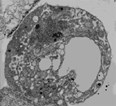Paraptosis — new pathway to programmed cell death

Paraptosis may be ancient and original form of cell death
While apoptosis has been the object of intensive study (a few years back, 20 articles on apoptosis were published each day), it's not the only way for cells to die, according to a recent study in The Proceedings of the National Academy of Sciences. In the December 19 issue, Dale Bredesen, president of Buck Institute (Novato, CA), along with colleagues from the Burnham Institute (La Jolla, CA) and the University of California, San Diego, report on a novel pathway they term paraptosis, which has some biochemical correlates with apoptosis, but which looks entirely different.
Paraptosis, which the researchers observed in a variety of cell types in response to insulin derived growth factor 1 receptor, has none of the morphological features associated with apoptosis—such as fragmentation of the cell, its nucleus, and its DNA. Instead, paraptosis is characterized by the formation of vacuoles in the cytoplasm, along with mitochondrial swelling, reminiscent of necrosis, a somewhat primitive path to cell death. However, what sets paraptosis apart from necrosis is its requirement for new RNA and protein synthesis, suggesting that it, like apoptosis, represents a distinct and programmed biochemical event.

An electron microscopic image of paraptosis
And in fact, further experiments showed that paraptosis, like apoptosis, does indeed involve a caspase, caspase-9, though the pathway appears to be different from how caspases function in apoptosis, as evidenced by its insensitivity to the caspase and apoptosis inhibitor BAF.

Comparison of apoptosis, necrosis and paraptosis (modified from Sperandio et al, PNAS, 97: 14376-81, 2000)
As further testament to its uniqueness, paraptotic cells are resistant to agents that block apoptosis, such as BAF, p35, and BCL. Intriguingly, paraptosis-like characteristics have been observed in lower organisms that existed prior to the evolution of apoptosis, implying that paraptosis may actually turn out to be the older cell death program.
The authors believe that characterization of this alternative form of programmed cell death may provide new insights into cell-death programs and their roles in development and degeneration.
"We are fascinated by paraptosis because it appears to occur during the development of the nervous system, as well as in some cases of neurodegeneration," said Bredesen. "Therefore, although it may be the road less traveled in dying cancer cells, it appears to be a well worn path in brain cells, and therefore a potentially important therapeutic target." Sabina Sperandio, lead author, said that the next steps for this research will involve a "functional genomic characterization of the pathway, involving follow-up of pilot microarray studies and protein interaction studies."
For more information: Dale Bredesen, Buck Institute for Age Research, 8001 Redwood Blvd., Novato, CA 94945. Email: dbredesen@buckinstitute.org.
Edited by Laura DeFrancesco
Managing Editor, Bioresearch Online
ldefrancesco@vertical.net
